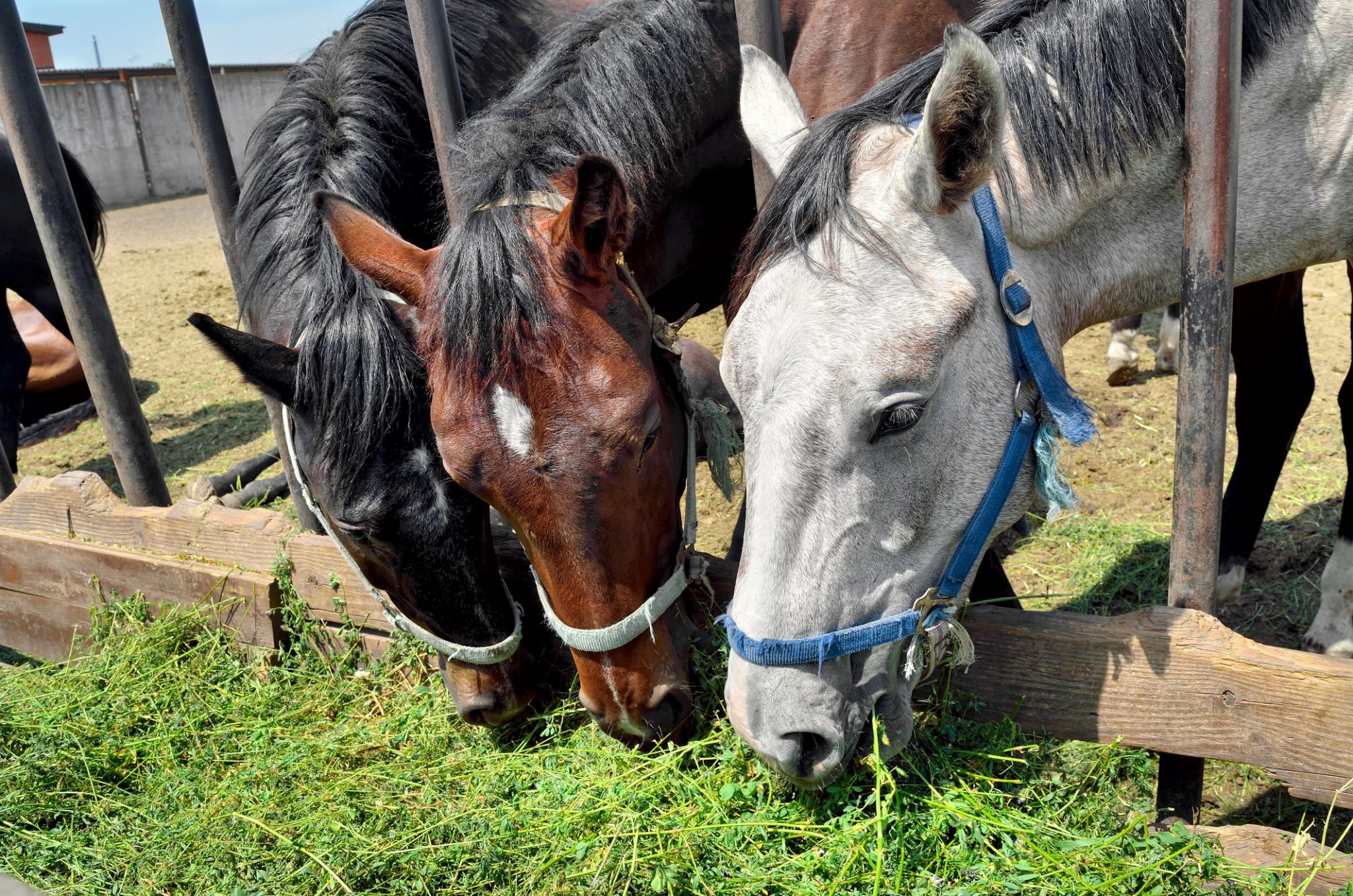Farming

Maintain the health and vitality of your horses by following these best practices for feeding management.
1. Put Forage First
Use good-quality forage. Leisure horses consume up to 2 1/2 percent of their body weight in forage per day. When consuming large amounts of concentrate, horses should be fed at least 1 percent of their body weight in forage per day. Adequate intake of good-quality forage is important for proper gut function. Good-quality hay generally is characterized by having a fresh (not musty) smell, green color, high leaf content, and no weeds and other debris. Pastures should be free of toxic weeds and trees and contain safe and palatable forages.
2. Maintain Clean, Fresh Water
On average, a horse consumes 8 to 12 gallons or more of water per day. Clean, fresh water should be available at all times, particularly before and after feeding. Exercising horses should be offered water immediately after working, but the amount it drinks at one time should be limited until the animal is cooled down.
3. Feed by Weight, Not by Volume
Feedstuffs vary in density, so a scoop of oats versus one of pellets has different weights. Commercial concentrates may vary across manufacturers or even from batch to batch. The same is true for hay as not all flakes or blocks within a bale are the same weight. A simple kitchen scale can be a handy tool in the feed room for ensuring that your horse gets the appropriate amount of feed.
4. Feed Small Meals
Feeding small meals ensures that a horse can better absorb nutrients before the feed passes into the hindgut for fermentation. If a horse consumes more than 0.75 percent of its body weight in concentrate per day, the concentrate should be divided into at least two equal meals. For an average 1,100-pound horse, anything over 8 pounds per day must be divided into at least two meals, although feeding multiple small meals can be even more beneficial.
5. Feed on Time
Feeding meals on a regular schedule, preferably every 12 hours, maximizes nutrient absorption and minimizes the risk of colic. If a horse requires more than 11⁄2 percent of its body weight in concentrate per day, the total amount fed should be divided evenly over three or four meals throughout a 24-hour period. For an 1,100-pound horse, anything over 16 pounds of concentrate needs to be divided into at least three feedings spaced 8 hours apart.
6. Maintain Proper Body Condition
Horses feel and perform best at their ideal body condition. For the average horse, this is a moderate body condition where the ribs can be easily felt but not seen, the back is relatively flat, withers have a rounded appearance, and the fat deposits around the tail head are slightly spongy. Broodmares should be kept closer to a fleshy body condition characterized by a crease down the back, spongy fat around the tailhead, and ribs that still can be felt even though there is fat between them.
7. Make Changes Slowly
It takes at least 2 weeks to safely switch a horse’s grain. When changing feeds, begin by substituting a small amount of new feed for the present feed (on a weight basis). Gradually increase the proportion of new feed until it is the only one offered. To increase (or decrease) the amount of feed offered, adjust the amount by 1⁄4 to 1⁄2 pound per feeding each day, allowing 1 or 2 days between increases. When introducing horses to pasture, limit grazing to 2 hours per day then gradually increase grazing time.
8. Keep Feeders Separated
When feeding horses in groups, use individual feeders for concentrates. Space feeders out of kicking range from one another yet close enough that all feed can be put out in a short amount of time. Providing each horse with its own feeder cuts down on fighting for feeder space.
9. Maintain Proper Storage
Minimize spoilage and contamination of feed by storing it properly. Store hay in a covered, dry place away from moisture that may cause toxic mold growth. Store grains and other concentrates in a secure area that keeps out rodents, insects, and wandering horses. Store all feeds and supplements away from chemicals and cleaners. Implement rodent control practices to reduce the spread of disease.
10. Use Grazing Management as an Ally
Under rotational management, pastures can be divided into smaller paddocks that allow animals to rotate at known forage regrowth intervals. This ensures uniform manure deposition and provides better forage quality for the horses. For further questions, consult your regional Extension agent.
 Megan Walker, Undergraduate Extension Intern, Liliane da Silva, Postdoctoral Fellow, Animal Sciences; and Leanne Dillard, Extension Specialist, Assistant Professor, Animal Sciences & Forages, all with Auburn University.
Megan Walker, Undergraduate Extension Intern, Liliane da Silva, Postdoctoral Fellow, Animal Sciences; and Leanne Dillard, Extension Specialist, Assistant Professor, Animal Sciences & Forages, all with Auburn University.
Reviewed March 2023, 10 Rules for Feeding Horses, ANR-1355

